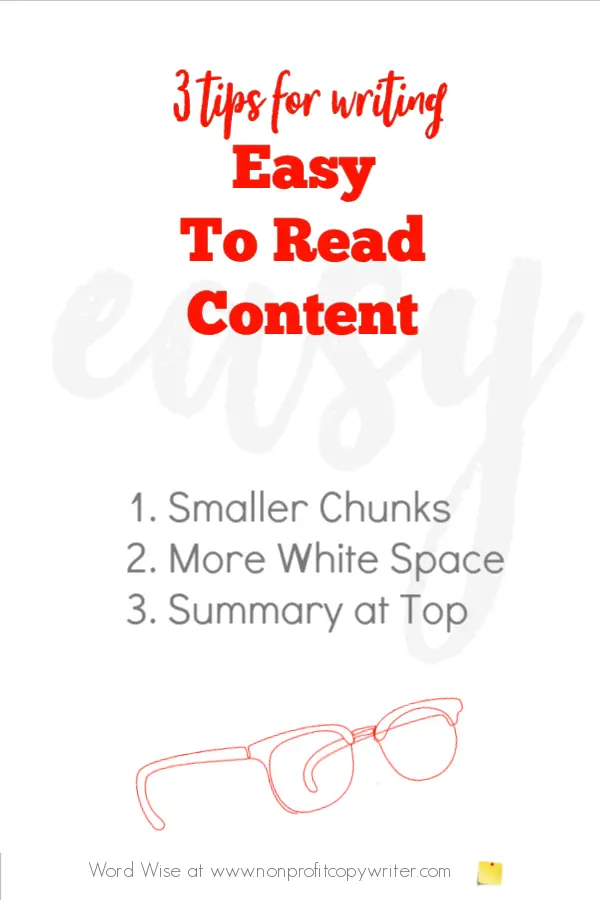Save Time: Get 5 Simple Writing Tips
you can put to use in 10 minutes
3 Tips for Writing Easy To Read Content
Award-winning writer Kathy Widenhouse has helped hundreds of nonprofits and writers produce successful content , with 750K+ views for her writing tutorials. She is the author of 9 books. See more of Kathy’s content here.
Updated 7.12.25
Avoid the Deadly TLDR Label with These Simple Writing Fixes
By writing easy to read content, you’ll appeal to more readers.
If you’re like me, you desperately want your content to avoid the TLDR label. I want readers to read what I’ve written, rather than skip it.
TLDR (sometimes TL;DR or tldr) is a popular internet acronym that stands for “Too Long; Didn’t Read.”
It’s an expression that’s become an online fixture – so much so that in 2018, the term was added to the Merriam-Webster Dictionary.
In most cases, content is TLDR-zoned when …
- the reader is overwhelmed at the length
- she is intimidated by its complexity
- she doesn’t think the content is worth her time
Occasionally, readers are lazy and type in a quick TLDR in your Comments, perhaps admitting they are Too Lazy, Didn’t Read. You cannot do anything about them. Let’s focus instead on those we can help move to the “Yes, I Read It” zone.
Here are 3 tips for writing easy to read content that keeps yours out of the TLDR no-man’s land and squarely on your reader’s eyeballs.
3 tips for writing easy to read content
Tip #1: Format content into smaller chunks
The simple answer to writing easy to read content is to write in shorter chunks.
Note I didn’t say write less content. Nor did I say write simplistic content. I’m making the assumption that your “long” content – an extensive web page, a long chapter, or a thorough article, for instance – is well-concepted, well-researched, and well-constructed. In other words, well worth your reader’s time.
So break up that fascinating content into smaller chunks. For instance, if you have a web page that clocks in at 2,500 words, then determine how to divide it into two or three sections. Format each section on a separate web page, with plenty of contextual links connecting the pages to each other. This makes your content more digestible.
And there’s another advantage of chunking, too: more exposure on the web. You’ll have three web pages rather than one. You’ll use unique keywords on each page, thereby tripling your site’s accessibility in keywords searches.
Tip #2: Use more white space
Gone are the days when readers are okay with long blocks of text, no matter how readable they may be. (The exceptions, of course, are legal briefs, academic pages, and technical journals.)
Writing easy to read content means writing short paragraphs (no more than 5-6 lines), varying your sentence length, including subheads to create an outline of sorts, and using plenty of bulleted lists. Ellipses, dashes, indentation, and parentheses give your readers’ eyes some breathing room, too. (Here's how to write better bullet points.)
In other words, avoid being TLDR-zoned when you use plenty of white space. That goes for both digital content and print content.
Tip #3: Write a TLDR summary
A TLDR Summary is a variation of the Inverted Pyramid format, known to journalists as a Summary News Lead Style or BLUF (Bottom Line Up Front). You give the reader the main point at the top of the piece. Use “TLDR” followed by your quick summary, like I might at the top of this post:
TLDR: write easy-to-read content with smaller chunks, white space, and a summary at the top.
As a writer, you can place a TLDR Summary at the beginning of an article, email, or web page as an introduction. Doing so saves the reader’s time. The summary gives her a reason to keep reading (she wants to know more) or gives her a reason to skip the rest of the content (it’s not pertinent to her).
As a reader or commenter, you can also jot down a quick and useful TLDR Summary in the Comments by way of helping other readers. Your summary acts like a letter’s P.S. Plenty of folks skim through Comments before investing time in the whole enchilada.
The best reason for writing easy to read content
An article or web page that is easy to read and is worth the reader’s time shows respect. You’re thinking about what’s best for the reader and how you can get information into her hands in the most accessible way.
And that’s one of the best reasons to write easy to read content.
More Quick Writing Tips
9 Quick Content Writing Tips for Beginners (and Pros!) ...
Simplify Your Writing: Why Word Choice Matters ...
Use the 4 Cs of Writing (But Only If You Want Readers to Understand You) ...
Slay Superlatives to Show, Rather Than Tell ...
How to Write Better Bullet Points ...
5 copywriting fixes to make you sound professional ...
How to write cleaner for better results ...
Readability check: an easy way to make your writing cleaner ...
Weed out weasel words for stronger writing ...
More Quick Writing Tips on our Pinterest board ...
4 Easy copywriting tricks anyone can master ...
Return from 3 Tips for Writing Easy to Read Content to Nonprofit Copywriter home
As an Amazon Associate I earn from qualifying purchases.
Share This Page

Named to 2022 Writer's Digest list
BEST GENRE/NICHE WRITING WEBSITE


Stop Wasting Time!
Grab your exclusive FREE guide, "5 Simple Writing Tips You Can Put to Use in 10 Minutes or Less"












